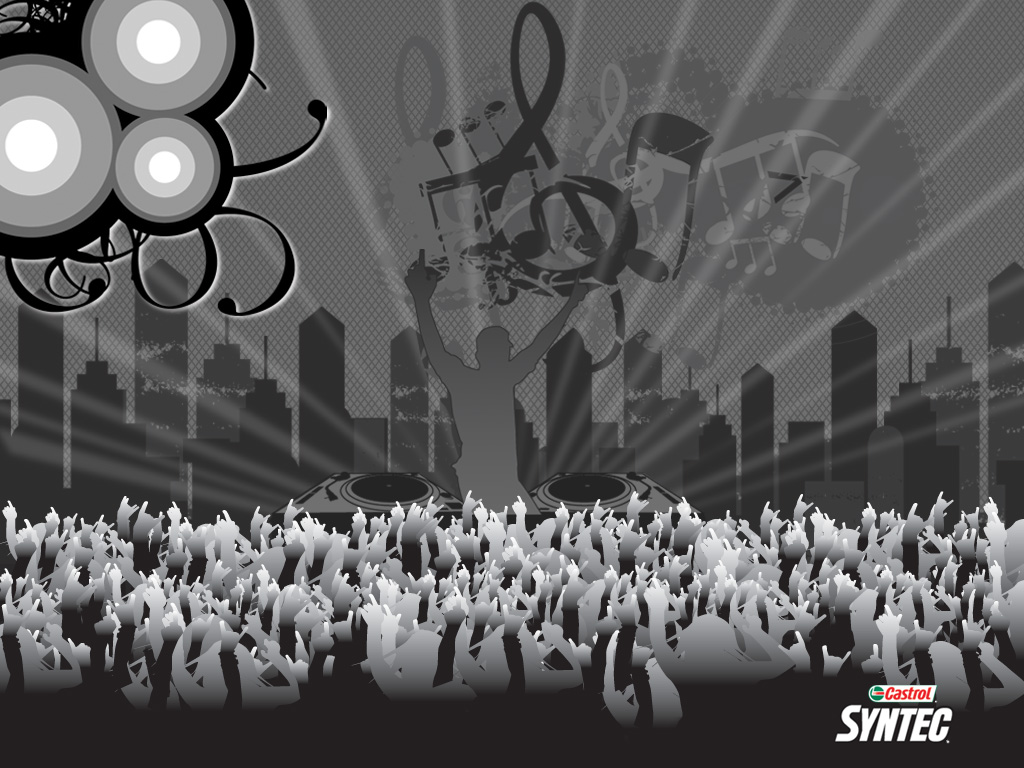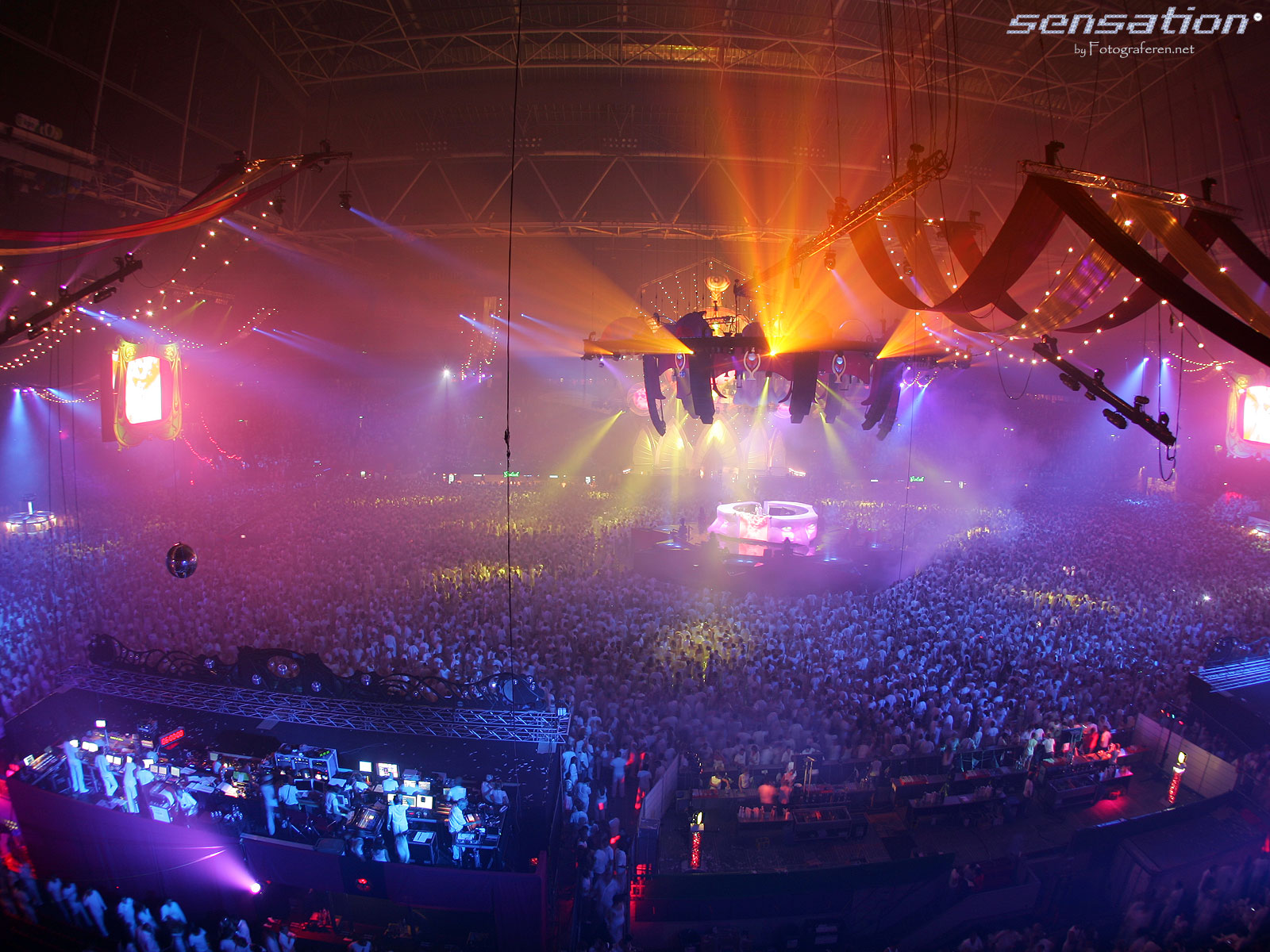By Joe Black
Ads by Google
SMS Marketing in Retail www.clickatell.com Learn how to Stand Out with SMS. This Festive Season - Dowload Guide
Worldcast DJ On Demand www.worldcastinc.com Book a Live entertainer from anywhere in the world
Rockin' in the New World www.RockinintheNewWorld.com A book from music pros detailing steps to make it big. Free chapter
Music Portal
Music is a form of art that involves organized and audible sounds and silence. It is normally expressed in terms of pitch (which includes melody and harmony), rhythm (which includes tempo and meter), and the quality of sound (which includes timbre, articulation, dynamics, and texture). Music may also involve complex generative forms in time through the construction of patterns and combinations of natural stimuli, principally sound. Music may be used for artistic or aesthetic, communicative, entertainment, or ceremonial purposes. The definition of what constitutes music varies according to culture and social context.
If painting can be viewed as a visual art form, music can be viewed as an auditory art form.
Allegory of Music, by Filippino Lippi
Allegory of Music, by Lorenzo Lippi
Contents
1 Definition
2 History
3 Aspects
4 Production 4.1 Performance
4.2 Solo and ensemble
4.3 Oral tradition and notation
4.4 Improvisation, interpretation, composition
4.5 Composition
//
[edit] Definition as seen by [http://www.FaceYourArt.com]
Main article: Definition of music
See also: Music genre
The broadest definition of music is organized sound. There are observable patterns to what is broadly labeled music, and while there are understandable cultural variations, the properties of music are the properties of sound as perceived and processed by humans and animals (birds and insects also make music).
Music is formulated or organized sound. Although it cannot contain emotions, it is sometimes designed to manipulate and transform the emotion of the listener/listeners. Music created for movies is a good example of its use to manipulate emotions.
Greek philosophers and medieval theorists defined music as tones ordered horizontally as melodies, and vertically as harmonies. Music theory, within this realm, is studied with the pre-supposition that music is orderly and often pleasant to hear. However, in the 20th century, composers challenged the notion that music had to be pleasant by creating music that explored harsher, darker timbres. The existence of some modern-day genres such as grindcore and noise music, which enjoy an extensive underground following, indicate that even the crudest noises can be considered music if the listener is so inclined.
20th century composer John Cage disagreed with the notion that music must consist of pleasant, discernible melodies, and he challenged the notion that it can communicate anything. Instead, he argued that any sounds we can hear can be music, saying, for example, "There is no noise, only sound,"[3]. According to musicologist Jean-Jacques Nattiez (1990 p.47-8,55): "The border between music and noise is always culturally defined--which implies that, even within a single society, this border does not always pass through the same place; in short, there is rarely a consensus.... By all accounts there is no single and intercultural universal concept defining what music might be."
Johann Wolfgang Goethe believed that patterns and forms were the basis of music; he stated that "architecture is frozen music."
[edit] History as seen by [http://www.FaceYourArt.com]
Main article: History of music
See also: Music and politics
Figurines playing stringed instruments, excavated at Susa, 3rd millennium BC. Iran National Museum.
The history of music predates the written word and is tied to the development of each unique human culture. Although the earliest records of musical expression are to be found in the Sama Veda of India and in 4,000 year old cuneiform from Ur, most of our written records and studies deal with the history of music in Western civilization. This includes musical periods such as medieval, renaissance, baroque, classical, romantic, and 20th century era music. The history of music in other cultures has also been documented to some degree, and the knowledge of "world music" (or the field of "ethnomusicology") has become more and more sought after in academic circles. This includes the documented classical traditions of Asian countries outside the influence of western Europe, as well as the folk or indigenous music of various other cultures. (The term world music has been applied to a wide range of music made outside of Europe and European influence, although its initial application, in the context of the World Music Program at Wesleyan University, was as a term including all possible music genres, including European traditions. In academic circles, the original term for the study of world music, "comparative musicology", was replaced in the middle of the twentieth century by "ethnomusicology", which is still considered an unsatisfactory coinage by some.)
Popular styles of music varied widely from culture to culture, and from period to period. Different cultures emphasised different instruments, or techniques, or uses for music. Music has been used not only for entertainment, for ceremonies, and for practical & artistic communication, but also extensively for propaganda.
As world cultures have come into greater contact, their indigenous musical styles have often merged into new styles. For example, the United States bluegrass style contains elements from Anglo-Irish, Scottish, Irish, German and some African-American instrumental and vocal traditions, which were able to fuse in the US' multi-ethnic "melting pot" society.
There is a host of music classifications, many of which are caught up in the argument over the definition of music. Among the largest of these is the division between classical music (or "art" music), and popular music (or commercial music - including rock and roll, country music, and pop music). Some genres don't fit neatly into one of these "big two" classifications, (such as folk music, world music, or jazz music).
Genres of music are determined as much by tradition and presentation as by the actual music. While most classical music is acoustic and meant to be performed by individuals or groups, many works described as "classical" include samples or tape, or are mechanical. Some works, like Gershwin's Rhapsody in Blue, are claimed by both jazz and classical music. Many current music festivals celebrate a particular musical genre.
There is often disagreement over what constitutes "real" music: late-period Beethoven string quartets, Stravinsky ballet scores, serialism, bebop-era Jazz, rap, punk rock, and electronica have all been considered non-music by some critics when they were first introduced.
[edit] Aspects as seen by [http://www.FaceYourArt.com]
Main article: Aspects of music
The traditional or classical European aspects of music often listed are those elements given primacy in European-influenced classical music: melody, harmony, rhythm, tone color or timbre, and form. A more comprehensive list is given by stating the aspects of sound: pitch, timbre, loudness, and duration.[1] These aspects combine to create secondary aspects including structure, texture and style. Other commonly included aspects include the spatial location or the movement in space of sounds, gesture, and dance. Silence has long been considered an aspect of music, ranging from the dramatic pauses in Romantic-era symphonies to the avant-garde use of silence as an artistic statement in 20th century works such as John Cage's 4'33."John Cage considers duration the primary aspect of music because it is the only aspect common to both "sound" and "silence."
As mentioned above, not only do the aspects included as music vary, their importance varies. For instance, melody and harmony are often considered to be given more importance in classical music at the expense of rhythm and timbre. It is often debated whether there are aspects of music that are universal. The debate often hinges on definitions. For instance, the fairly common assertion that "tonality" is universal to all music requires an expansive definition of tonality.
A pulse is sometimes taken as a universal, yet there exist solo vocal and instrumental genres with free, improvisational rhythms with no regular pulse;[2] one example is the alap section of a Hindustani music performance. According to Dane Harwood, "We must ask whether a cross-cultural musical universal is to be found in the music itself (either its structure or function) or the way in which music is made. By 'music-making,' I intend not only actual performance but also how music is heard, understood, even learned." [3]
[edit] Production
Main article: Music industry
Music is composed and performed for many purposes, ranging from aesthetic pleasure, religious or ceremonial purposes, or as an entertainment product for the marketplace. Amateur musicians compose and perform music for their own pleasure, and they do not attempt to derive their income from music. Professional musicians are employed by a range of institutions and organizations, including armed forces, churches and synagogues, symphony orchestras, broadcasting or film production companies, and music schools. As well, professional musicians work as freelancers, seeking contracts and engagements in a variety of settings.
Although amateur musicians differ from professional musicians in that amateur musicians have a non-musical source of income, there are often many links between amateur and professional musicians. Beginning amateur musicians take lessons with professional musicians. In community settings, advanced amateur musicians perform with professional musicians in a variety of ensembles and orchestras. In some rare cases, amateur musicians attain a professional level of competence, and they are able to perform in professional performance settings.
A distinction is often made between music performed for the benefit of a live audience and music that is performed for the purpose of being recorded and distributed through the music retail system or the broadcasting system. However, there are also many cases where a live performance in front of an audience is recorded and distributed (or broadcast).
[edit] Performance
Main article: Performance
Chinese Naxi musicians
Someone who performs, composes, or conducts music is a musician. Musicians perform music for a variety of reasons. Some artists express their feelings in music. Performing music is an enjoyable activity for amateur and professional musicians, and it is often done for the benefit of an audience, who is deriving some aesthetic, social, religious, or ceremonial value from the performance. Part of the motivation for professional performers is that they derive their income from making music. Not only is it an income derived motivation, music has become a part of life as well as society. Allowing one to be motivated through self intrinsic motivations as well, as a saying goes "for the love of music." As well, music is performed in the context of practicing, as a way of developing musical skills.
[edit] Solo and ensemble
Many cultures include strong traditions of solo or soloistic performance, such as in Indian classical music, and in the Western Art music tradition. Other cultures, such as in Bali, include strong traditions of group performance. All cultures include a mixture of both, and performance may range from improvised solo playing for one's enjoyment to highly planned and organized performance rituals such as the modern classical concert or religious processions.
Chamber music, which is music for a small ensemble with no more than one of each type of instrument, is often seen as more intimate than symphonic works. A performer is called a musician or singer, and they may be part of a musical ensemble such as a rock band or symphony orchestra.
[edit] Oral tradition and notation
Main article: Musical notation
Musical notation
Music is often preserved in memory and performance only, handed down orally, or aurally ("by ear"). When the composer of music is no longer known, this music is often classified as "traditional". Different musical traditions have different attitudes towards how and where to make changes to the original source material, from quite strict, to those which demand improvisation or modification to the music. In the Gambia, West Africa, the history of the country is passed aurally through song.
When music is written down, it is generally notated so that there are instructions regarding what should be heard by listeners, and what the musician should do to perform the music. This is referred to as musical notation, and the study of how to read notation involves music theory, harmony, the study of performance practice, and in some cases an understanding of historical performance methods.
Written notation varies with style and period of music. In Western Art music, the most common types of written notation are scores, which include all the music parts of an ensemble piece, and parts, which are the music notation for the individual performers or singers. In popular music, jazz, and blues, the standard musical notation is the lead sheet, which notates the melody, chords, lyrics (if it is a vocal piece), and structure of the music. Nonetheless, scores and parts are also used in popular music and jazz, particularly in large ensembles such as jazz "big bands."
In popular music, guitarists and electric bass players often read music notated in tablature, which indicates the location of the notes to be played on the instrument using a diagram of the guitar or bass fingerboard. Tabulature was also used in the Baroque era to notate music for the lute, a stringed, fretted instrument.
Generally music which is to be performed is produced as sheet music. To perform music from notation requires an understanding of both the musical style and the performance practice that is associated with a piece of music or genre. The detail included explicitly in the music notation varies between genres and historical periods. In general, art music notation from the 17th through to the 19th century required performers to have a great deal of contextual knowledge about performing styles.
For example, in the 17th and 18th century, music notated for solo performers typically indicated a simple, unornamented melody. However, it was expected that performers would know how to add stylistically-appropriate ornaments such as trills and turns.
In the 19th century, art music for solo performers may give a general instruction such as to perform the music expressively, without describing in detail how the performer should do this. It was expected that the performer would know how to use tempo changes, accentuation, and pauses (among other devices) to obtain this "expressive" performance style.
In the 20th century, art music notation often became more explicit, and used a range of markings and annotations to indicate to performers how they should play or sing the piece. In popular music and jazz, music notation almost always indicates only the basic framework of the melody, harmony, or performance approach; musicians and singers are expected to know the performance conventions and styles associated with specific genres and pieces.
For example, the "lead sheet" for a jazz tune may only indicate the melody and the chord changes. The performers in the jazz ensemble are expected to know how to "flesh out" this basic structure by adding ornaments, improvised music, and chordal accompaniment.
[edit] Improvisation, interpretation, composition
Main articles: Musical composition, Musical improvisation, and Free improvisation
Most cultures use at least part of the concept of preconceiving musical material, or composition, as held in western classical music. Even when music is notated precisely, there are still many decisions that a performer has to make. The process of a performer deciding how to perform music that has been previously composed and notated is termed interpretation.
Different performers' interpretations of the same music can vary widely. Composers and song writers who present their own music are interpreting, just as much as those who perform the music of others or folk music. The standard body of choices and techniques present at a given time and a given place is referred to as performance practice, where as interpretation is generally used to mean either individual choices of a performer, or an aspect of music which is not clear, and therefore has a "standard" interpretation.
In some musical genres, such as jazz and blues, even more freedom is given to the performer to engage in improvisation on a basic melodic, harmonic, or rhythmic framework. The greatest latitude is given to the performer in a style of performing called free improvisation, which is material that is spontaneously "thought of" (imagined) while being performed, not preconceived. According to the analysis of Georgiana Costescu, improvised music usually follows stylistic or genre conventions and even "fully composed" includes some freely chosen material (see precompositional). Composition does not always mean the use of notation, or the known sole authorship of one individual.
Music can also be determined by describing a "process" which may create musical sounds, examples of this range from wind chimes, through computer programs which select sounds. Music which contains elements selected by chance is called Aleatoric music, and is often associated with John Cage and Witold Lutoslawski.
[edit] Composition
Musical composition is a term that describes the composition of a piece of music. Methods of composition vary widely from one composer to another, however in analyzing music all forms -- spontaneous, trained, or untrained -- are built from elements comprising a musical piece. Music can be composed for repeated performance or it can be improvised; composed on the spot. The music can be performed entirely from memory, from a written system of musical notation, or some combination of both. Study of composition has traditionally been dominated by examination of methods and practice of Western classical music, but the definition of composition is broad enough to include spontaneously improvised works like those of free jazz performers and African drummers.
What is important in understanding the composition of a piece is singling out its elements. An understanding of music's formal elements can be helpful in deciphering exactly how a piece is constructed. A universal element of music is how sounds occur in time, which is referred to as the rhythm of a piece of music.
When a piece appears to have a changing time-feel, it is considered to be in rubato time, an Italian expression that indicates that the tempo of the piece changes to suit the expressive intent of the performer. Even random placement of random sounds, which occurs in musical montage, occurs within some kind of time, and thus employs time as a musical element.
[edit] Reception and audition as seen by FaceYourArt.com
Main article: Hearing (sense)
Concert in the Mozarteum, Salzburg
The field of music cognition involves the study of many aspects of music including how it is processed by listeners.
Music is experienced by individuals in a range of social settings ranging from being alone to attending a large concert. Musical performances take different forms in different cultures and socioeconomic milieus. In Europe and North America, there is often a divide between what types of music are viewed as a "high culture" and "low culture." "High culture" types of music typically include Western art music such as Baroque, Classical, Romantic, and modern-era symphonies, concertos, and solo works, and are typically heard in formal concerts in concert halls and churches, with the audience sitting quietly in seats.
On the other hand, other types of music such as jazz, blues, soul, and country are often performed in bars, nightclubs, and theatres, where the audience may be able to drink, dance, and express themselves by cheering. Until the later 20th century, the division between "high" and "low" musical forms was widely accepted as a valid distinction that separated out better quality, more advanced "art music" from the popular styles of music heard in bars and dance halls.
However, in the 1980s and 1990s, musicologists studying this perceived divide between "high" and "low" musical genres argued that this distinction is not based on the musical value or quality of the different types of music. Rather, they argued that this distinction was based largely on the socioeconomic standing or social class of the performers or audience of the different types of music.
For example, whereas the audience for Classical symphony concerts typically have above-average incomes, the audience for a hip-hop concert in an inner-city area may have below-average incomes. Even though the performers, audience, or venue where non-"art" music is performed may have a lower socioeconomic status, the music that is performed, such as blues, hip-hop, punk, funk, or ska may be very complex and sophisticated.
Deaf people can experience music by feeling the vibrations in their body, a process which can be enhanced if the individual holds a resonant, hollow object. A well-known deaf musician is the composer Ludwig van Beethoven, who composed many famous works even after he had completely lost his hearing. Recent examples of deaf musicians include Evelyn Glennie, a highly acclaimed percussionist who has been deaf since the age of twelve, and Chris Buck, a virtuoso violinist who has lost his hearing.
Further information: psychoacoustics













.jpg)



























































































































If you are a producer, director or project coordinator for any type of film, television or video project, you know how challenging it can be to find production music that encapsulates fully the important themes and the message of your project. Not only is production music and background music for film and television often incredibly expensive, but the time required to shop around to the multitude of music providers or composers is also extensive. And since musical originality is often a concern, typically producers with limited budgets that can't afford to pay a composer to create a score of music specifically for their film, television show or video project, but can buy popular music or previously used film scores run the risk of hearing the very same production music and background music they paid so dearly for in another film weeks or months later.
Many film and television professionals that do not have multi-million dollar budgets wonder what to look for in high quality production music. Because the market for background music of all varieties, particularly those that claim to be "affordable" and "original" can be so inundated with poor-sounding, purely imitative scores and individual musical pieces, weeding through the rocks to find the gems can be a painstaking process for which no one has the time or energy.
The following are four important elements to look for when shopping for the right production music and background music for your film, television or video project:
1. Excellent sound quality. This may seem like an obvious element, because it is often the most immediately noticeable when listening to good music, but many don't think about sound quality unless it is very bad. If you are a producer or director, you probably have an understanding of sound quality in film or television, but may be less certain of your ability to gauge it in production music and background music. If you don't have the benefit of having a musical expert on staff, you can certainly gauge the quality of the music yourself by thinking about a few important aspects. If the music has been recorded under the best conditions, you will hear a perfect balance between bass and treble, as well as consistent sound and textures regardless of the volume at which you are listening to the music. You will be able to pick out the individual sounds of different instruments and not just a muddle of sounds, some fairly indistinguishable.
2. Vivid, true instrumentation. Some production music that claims to be "affordable" sounds more like bad elevator music or music that has been recorded in a dark room by someone's younger brother using a cheap synthesizer from the 1980's. Even if the music is synthesized (and as a professional with a limited budget, you should understand that sometimes it has to be in order to keep costs down), it does not have to sound fake and hollow. Synthesizers are capable of producing instrument sounds that are true-to-life, and the best production music and background music will have depth and approach if not fully embody the richness and intricacies of real violins, cellos, brass, woodwinds, electric guitars and percussion. If you can tell the instruments are merely simulated, your audience will know as well.
3. Originality. This one seems like something obvious to look for in great production music, but is actually much more complicated than at first thought. If you can't afford popular music, or don't want to risk hearing the music you've selected in other films or television programs that have nothing to do with your unique project, you want to find background music that is exciting and innovative, but also makes some musical sense and has continuity, and most importantly, fits the overall feeling of your production. First-rate production music will have technical accuracy and stylistic importance, but will be special and able to stand alone as a piece of good music. Still, as a producer, director or project coordinator you will want something original that still invokes the attitude and style of your film and perhaps even reminds audiences of the popular pieces of music you could not afford.
4. Well-written and -performed music by artists with real and verifiable credentials. Production music providers, even the smaller ones, that are legitimate and of the finest quality will provide credentials for the artists and composers they enlist, and will have full and confirmable information about all aspects of their production music. Film and television professionals should be prepared to ask specific questions of these providers if this history is not readily available, because sometimes a very new production music provider will have talented musicians involved, but not necessarily yet have the resume to prove it. If the provider's music has been used in other films and projects, you should ask for a list and make sure the projects are similar or at least remotely relevant in style and quality to your production.
Everyone has had the experience of buying popular music, even at cheaper prices, only to hear it in every film that comes out in the same year. Many producers and directors are thinking about alleviating the struggle of searching for production music by turning to providers of royalty free music and royalty free production music to fulfill their complex needs. Royalty free music and buyout music offers an excellent alternative to the hassle of searching for the right production music that fits a tight budget. Clients of royalty free production music companies pay a one-time, low fee and gain unlimited use of the pieces of music.
Companies such as Award Winning Music and http://www.royaltyfreemusic.com offer a very comprehensive library of royalty free music and royalty free production music that will suit the many and discriminating needs of producers, directors and project coordinators, and even offer experts that will help design packages of royalty free music and buyout music or even entire film scores for film, television and video projects at a fraction of the cost of the major music providers. Buyout music and royalty free music is an excellent option for professionals looking to communicate the themes and attitude of their project, and will make a film sound as original as it would had a score been created specifically for it.